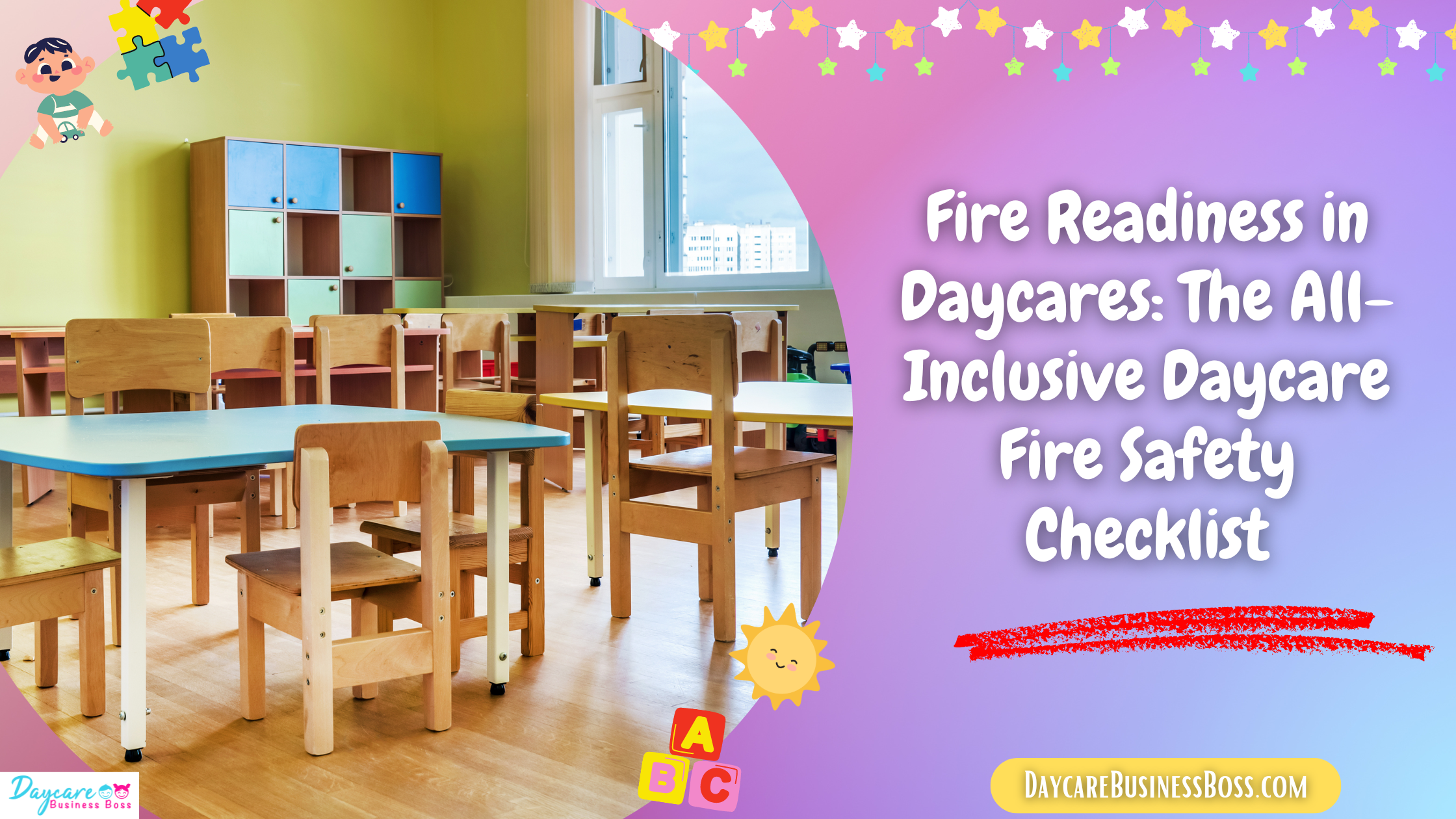Daycare facilities are critical in nurturing and molding the development of young children. As parents commit their children to these facilities, their safety becomes a top priority. It is critical to establish a setting that is not only stimulating but also safe from potential threats in a bustling environment of inquiring minds and joyful activities. Implementing a thorough daycare fire inspection checklist is one of the most important strategies for ensuring this safety.
To effectively enhance daycare safety, you should begin with a comprehensive fire inspection checklist that includes working smoke alarms, fire extinguishers, clear exits, emergency plans, evacuation drills, flame-resistant materials, electrical safety, kitchen precautions, staff training, and compliance with local fire codes.
Importance of a Comprehensive Fire Inspection Checklist
Daycare safety extends beyond routine supervision to include proactive steps to ensure preparedness for unforeseen events, with a focus on fire occurrences. Implementing a detailed fire inspection checklist emerges as a critical method for improving safety standards. This checklist, which serves as a well-structured blueprint, plays a key role in avoiding the potential hazards associated with fires, so protecting the lives of not only the children under the care of the daycare but also the dedicated staff members and any visiting individuals.
The importance of this checklist can be seen in its multidimensional approach. It includes things like a fire alarm and sprinkler system functionality, clear and accessible evacuation routes, well-kept fire extinguishers, and personnel training in fire response methods. Daycare facilities can significantly lower the chance of fire-related accidents and their fatal consequences by carefully addressing these aspects.
Working Smoke Alarms
Working smoke alarms are the major barrier against the possibility of fires and are an essential component of safety measures. Their critical duty is to provide people with an important early warning signal, allowing them to escape the premises before a fire escalates into a dangerous situation. The efficacy of smoke alarms, on the other hand, is dependent on their consistent performance, emphasizing the importance of routine maintenance and testing processes.
Regular maintenance ensures that these alarms are ready to go when they are needed the most. By performing periodic checkups, daycare centers can quickly identify and correct any defects or battery deficiencies that may jeopardize the functionality of the alarms. This commitment to maintenance strikes me as a proactive approach to protecting lives and property.
It is also critical to strategically put these smoke alarms throughout the daycare center. A well-planned placement strategy ensures complete coverage while eliminating blind areas and increasing the possibility of early detection. To eliminate weaknesses, critical places such as sleeping quarters, playrooms, kitchens, and halls must be supplied with these alarms.
Fire Extinguishers
Fire extinguishers are essential weapons in the arsenal against small fires, acting as quick responders capable of effectively putting out potential infernos before they progress into unmanageable catastrophes. The strategic location of these extinguishers is critical since they must be easily accessible throughout the daycare center. This accessibility guarantees that staff responds quickly to fire outbreaks, reducing the risk of fire propagation and increasing the possibility of containment.
The staff’s expertise and proficiency with fire extinguishers are also important. Thorough training equips caregivers and staff to confidently and correctly launch these firefighting devices, avoiding unneeded stress and allowing for a quick reaction. Their training should include not only correct usage but also frequent maintenance practices to increase the reliability of the extinguishers.
Regular inspection and servicing are critical components of keeping the extinguishers operational. Periodic inspections address issues such as pressure levels, physical integrity, and expiration dates, ensuring that the extinguishers are ready to go when they are needed the most. This care demonstrates a proactive commitment to fire safety, eliminating potential threats and strengthening the center’s overall emergency preparation.
Clear Exits
The importance of unobstructed exits in the field of daycare safety cannot be emphasized. These paths provide the foundation of a safe environment, providing a vital escape route for both children and staff in the case of a fire or disaster. The smooth operation of departure routes facilitates a quick and planned evacuation, potentially avoiding mayhem and saving lives.
Frequent and rigorous inspections are essential to the upkeep of these exit routes. The assurance of unobstructed roads is based on regular examinations that take into account a variety of criteria. Doors and gates, which are critical components of escape pathways, should be thoroughly inspected to ensure they open smoothly and without difficulty. The path itself should be clear of any impediments to a quick evacuation.
These inspections are woven into the greater web of preventative safety measures. The attentive maintenance of evacuation routes not only complies with regulatory standards but also symbolizes the daycare’s constant dedication to the well-being of its residents. The creation of a safe environment fosters confidence among parents and caregivers, thereby reinforcing the daycare’s reputation as a reputable and secure organization.
Read more about: Every Detail Counts: Your Child’s Safety in the Home Daycare Inspection Checklist
Emergency Plans
The significance of well-designed emergency plans cannot be emphasized; they are the foundation of a safe and secure daycare environment. These meticulously detailed plans serve a key role in directing the behavior of both professionals and children during critical occasions. Comprehensive emergency protocols should include a wide range of eventualities, including fire disasters, and detailed step-by-step methods for evacuating the facility, assuring all inhabitants’ safe escape, and collaborating with local emergency services.
The sheer presence of these plans, however, is insufficient. Regular drills and exercises help to instill these protocols in the brains of all stakeholders. Practice turns theoretical knowledge into real preparedness, allowing staff and children to get acquainted with evacuation routes, assembly points, and communication systems. These simulated scenarios foster a preparation culture in which reflexes become automatic and well-coordinated, resulting in a quick and ordered response in the event of a genuine emergency.
Evacuation Drills
Evacuation exercises are extremely important since they act as useful instruments for preparing children and employees to handle fire crises with accuracy. These exercises are more than just drills; they are dynamic simulations that play an important part in creating a culture of safety and preparation in a daycare setting. Regularly executing these drills leads to the formation of a calm and assured mindset, which benefits both the children and the professionals.
Participants develop a sense of serenity and confidence as a result of continuous practice. Children become acquainted with the evacuation protocols, gaining a firm grasp of the activities that must be taken and the courses that must be taken. During these exercises, staff members gain skills in guiding and arranging youngsters, providing a smooth and coordinated evacuation process.
The importance of these drills goes beyond their immediate impact. They promote a resilient workplace in which everyone is prepared to manage emergencies with grace. Evacuation exercises foster confidence by transforming theoretical understanding into practical preparation. They enable children and staff to negotiate difficult situations with purpose, transforming uncertainty into a well-coordinated and confident reaction.
Flame-Resistant Materials

The adoption of flame-resistant materials within daycare facilities is a critical step in reducing the spread of flames. This smart choice extends to different facets of the environment, ranging from furniture selection to space decoration. Choosing materials that are naturally resistant to igniting is a critical step toward protecting the lives of children, workers, and visitors alike. The probability of a little spark growing into a catastrophic inferno is significantly reduced by minimizing the likelihood of fire getting onto certain materials.
The long-term consequences of such a decision cannot be overstated. In the event of a fire, using flame-resistant materials buys valuable time for evacuation and containment measures, perhaps averting a disaster. The usage of these products reflects a proactive commitment to safety that parents and caregivers appreciate, demonstrating that the childcare center emphasizes the well-being of its residents.
However, the achievement of flame-resistant materials is dependent on constant monitoring. The inspection of these materials regularly assures their continuing performance and conformity to safety regulations. Wear and tear can degrade their resistance over time, making frequent checks necessary to maintain the appropriate level of protection. Daycare centers build a holistic approach to fire safety that is anchored in prevention and vigilance by investing in both initial material selection and ongoing evaluation.
Electrical Safety
Another critical aspect of daycare security is electrical safety. The threat of faulty wiring and malfunctioning electrical systems looms as a potential fire hazard in an atmosphere buzzing with electronic gadgets and equipment. The need for this safety feature stems from the fact that electrical fires can ignite quickly and violently, putting lives and property in danger.
Routine electrical inspections and careful maintenance practices act as a safeguard against such dangers. Regular assessments serve as a preventative strategy, capable of identifying possible concerns before they become critical. These inspections reduce the risk of electrical fires by discovering and correcting wiring irregularities, loose connections, or compromised equipment, ensuring that the daycare’s environment remains secure.
The proactive approach taken by doing frequent electrical tests reflects an institution’s dedication to the highest safety standards. It emphasizes a responsibility that goes beyond mere compliance, demonstrating real concern for the well-being of children, employees, and guests. The creation of such an environment is symptomatic of a daycare center that goes to great lengths to provide a haven where fire hazards are carefully reduced.
Kitchen Precautions
Daycare kitchens, which are bustling with cooking activities, are possible fire hotspots that require constant attention to safety. Culinary tasks requiring heat and flammable materials increase the risk of fire breakouts. However, strict safety measures can considerably reduce these hazards and establish the kitchen as a zone of controlled precaution rather than impending danger.
The appropriate storage of combustible items is critical to this undertaking. The potential of unintentional igniting is reduced by strict adherence to criteria for keeping flammable material in designated places. Frequent maintenance of kitchen appliances is critical in lowering fire risks. Keeping stoves, ovens, and other cooking equipment in good operating order reduces the likelihood of electrical faults that could lead to fires.
Staff training in fire-safe cooking procedures is essential for kitchen safety. Equipping them with knowledge about proper equipment handling, proper use of fire extinguishing systems, and fast response to possible threats adds to a proactive fire prevention workplace. Daycare facilities create confidence in parents and guardians by cultivating a culture in which every staff member is well-versed in fire safety. This assures them that their children are in the care of competent and aware professionals.
Read more about: Creating a Secure Haven: Essential Safety Measures for Family Daycare Homes
Staff Training
The well-trained personnel is the foundation of a safe daycare environment. Because these employees are the first line of defense against potential hazards, extensive training sessions are an essential component of safety standards. These courses, which cover a wide range of vital issues, are a critical investment in safeguarding the well-being of both children and staff.
Training should include all aspects of fire safety, preparing employees to prevent possible fire threats, and effectively responding to crises. Critical evacuation protocols must be ingrained in the consciousness of all staff members. A comprehensive grasp of evacuation routes, assembly places, and procedures for directing children during evacuations improves the process’s efficiency.
Equally vital is the right use of fire extinguishers, which transforms workers into skilled responders capable of tackling small fires before they spread. Another important pillar to consider is first aid training. Staff with first aid knowledge can provide prompt care in the event of an emergency, potentially reducing the severity of the crisis.
The definition of duties and responsibilities during emergencies is a key component of these training sessions. Clarity about each staff member’s responsibilities improves coordination, reduces confusion, and maximizes response effectiveness. When everyone understands their role in the safety strategy, the facility transforms into a well-oiled machine capable of handling situations with poise.
Compliance with Local Fire Codes
It is unquestionably necessary to strive for rigorous conformity to local fire codes within daycare facilities. These standards serve as a complete framework that has been painstakingly created to protect the lives of residents as well as the integrity of the environment. They provide a variety of safety rules that have been precisely customized to the special issues that daycare environments present. Daycare centers that embrace and execute these guidelines display an unshakable dedication to the highest safety standards.
The essence of these codes is their ability to prevent fire hazards. Regular assessments and updating of safety measures by local codes are critical to ensuring a secure environment. These codes are updated to reflect the most recent advances in fire safety and prevention. Daycare facilities can lower the risk of fire outbreaks and associated hazards by implementing the most recent research.
Such proactive participation with fire standards goes beyond mere compliance; it cements the daycare’s reputation as a responsible institution. Parents and guardians entrust their children to facilities that prioritize safety, and compliance with fire codes exemplifies this commitment. This dedication goes beyond rules, cultivating a culture of alertness and preparedness.
Frequently Asked Questions

Why is a thorough fire inspection checklist necessary for childcare safety?
A thorough fire inspection checklist is essential for childcare safety since it specifies precise procedures to prevent and respond to fire crises. Working smoke alarms, fire extinguishers, clear exits, evacuation drills, and staff training are all part of it. This checklist serves as a proactive guide to protect the safety of children, employees, and visitors while minimizing fire hazards.
How frequently should fire drills and inspections take place in a daycare setting?
To maintain a high level of preparation, fire drills, and inspections should be undertaken regularly in a childcare setting. Fire drills, including evacuation drills, should be held at least once a month to ensure that children and staff are aware of emergency procedures. Smoke alarms, fire extinguishers, exits, and other safety measures should be inspected quarterly or as recommended by local requirements.
How important is staff training in childcare fire safety?
Staff training is an essential component of childcare fire safety. Staff members who have been properly trained are prepared to respond effectively in the case of a fire, ensuring the safety of both children and themselves. Fire prevention, evacuation methods, the use of fire extinguishers, first aid, and other topics are covered in training. Staff are kept aware and confident in their abilities to handle fire-related emergencies through regular training sessions and refreshers.
To learn more on how to start your own daycare checkout my startup documents here.
The information provided by DaycareBusinessBoss.com (“The Site”) is for general informational purposes only. All information on the Site is provided in good faith, however, we make no representation or warranty of any kind, express or implied, regarding the accuracy, adequacy, validity, reliability, availability or completeness of any information on the Site. Under no circumstance shall we have any liability to you for any loss or damage of any kind incurred as a result of the use of the Site or Reliance on any information provided on the Site. Your use of the Site and your reliance on any information on the Site is solely at your own risk.
This blog post is for educational purposes only and does not constitute legal advice. Please consult a legal expert to address your specific needs. Terms and Conditions. (https://daycarebusinessboss.com/terms-conditions/)

Meet Shawn Chun: Entrepreneur and Childcare Business Fan.
I’m a happy individual who happens to be an entrepreneur. I have owned several types of businesses in my life from a coffee shop to an import and export business to an online review business plus a few more and now I create online daycare business resources for those interested in starting new ventures. It’s demanding work but I love it. I do it for those passionate about their business and their goals. That’s why when I meet a childcare business owner, I see myself. I know how hard the struggle is to retain clients, find good employees and keep the business growing all while trying to stay competitive.
That’s why I created Daycare Business Boss: I want to help childcare business owners like you build a thriving business that brings you endless joy and supports your ideal lifestyle.

